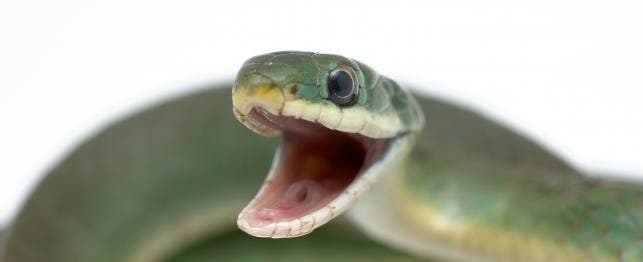
Reptile Senses: Understanding Their World
According to fossil records, reptiles first appeared on earth more than 300 million years ago. Like all other living organisms, they have survived by acquiring information about the environment through the senses – sight, smell and hearing – and a few other specialized senses for life in the reptile world.
Most people are aware that reptiles rely on environmental temperature to regulate their body temperature. But, what do reptiles see, hear, taste or smell? Since senses vary from species to species, it’s a difficult question to answer, and what we do know is mostly learned through the study of snakes.
Vision
Vision in snakes varies tremendously. Some are completely blind, some can only detect light and dark, and still others have very keen vision. For most, their vision is adequate but not sharp. They can track movement, but they cannot differentiate between a hamster and a gerbil.
Based on examination of snake retinas, it is thought that snakes have some color vision but not as broad a range as people. As with other reptiles, snakes have a yellow filter that absorbs ultraviolet light and protects the eyes. Due to limited eye mobility, snakes use a combination of infrared vision and chemosensation to find their prey and recognize features in their environment.
When compared to snakes, lizards and turtles are thought to be able to perceive a greater number of colors. Some may even be able to see colors in the ultraviolet range. Lizards have the ability to alter the shape of their lenses within their eyes to focus on near and far objects.
Reptiles active at night tend to have smaller eyes than those active during the day. The pupils of nocturnal species tend to be relatively large. This improves the reptile’s ability to gather light but reduces their visual acuity. Many nocturnal species have slit-shaped pupils. Species active during the day tend to have round pupils.
Hearing
For snakes, hearing is one of their poorest senses. With only a simple inner ear, snakes can only detect ground vibrations or airborne vibrations of low frequency.
For other species, hearing abilities vary. Most can hear at least low pitch noises. A majority of reptiles have an eardrum, middle ear and inner ear, allowing for at least some hearing ability.
Smell and Taste
As in humans, the senses of smell and taste work together. However, in reptiles, these senses are thought to be interrelated and not separate senses. Reptiles have a specialized chemically sensitive organ called the Jacobson’s organ that is thought to be able to convert tastes into smells, and boosts his awareness of his surroundings. Snakes and lizards flick their tongue, capturing particles in the air. They then press these particles against the Jacobson’s organ, located in the roof of the mouth, which processes the particles and provides the reptile with necessary environmental information. This organ helps the reptile find prey, find appropriate mates and can even detect nearby predators.
Special Organs
Snakes have a special organ that is sensitive to heat. These organs line the lips of some boas and pythons and are also located on either side of the head of pit vipers. These organs sense infrared radiation, picking up on the warmth of nearby animals. This special sense organ is so sensitive that it can detect a temperature change of as little as 2/1000 of a degree. This helps the snake detect and accurately strike at prey, even in complete darkness.